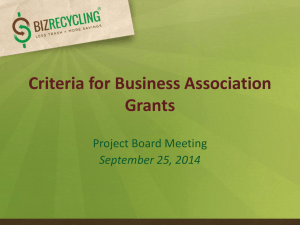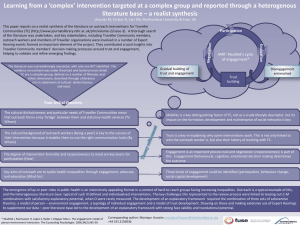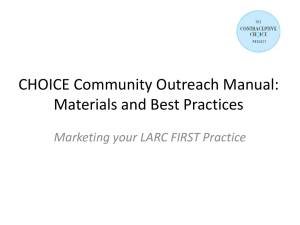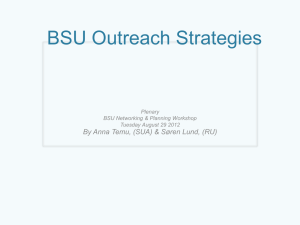Course slide presentation
advertisement
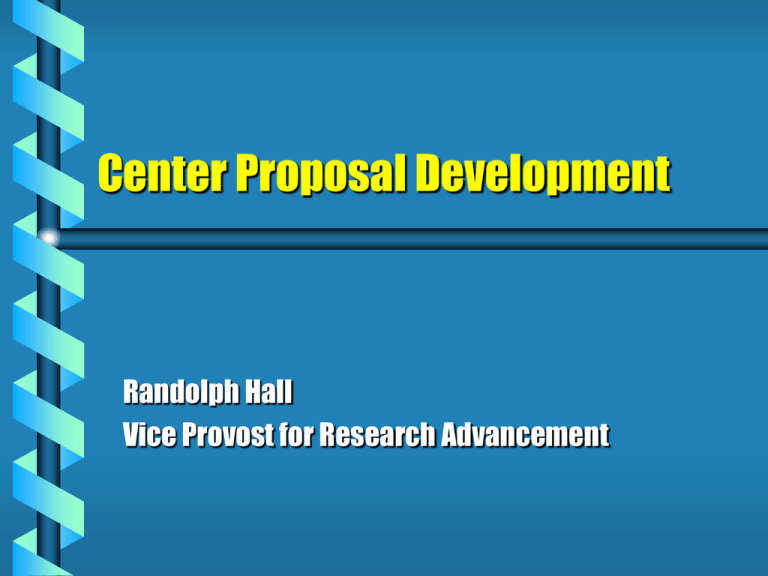
Center Proposal Development Randolph Hall Vice Provost for Research Advancement Why Pursue Centers? Impact Extends Beyond What You Can Personally Accomplish New Types of Research, Crossing Disciplines, Linking Applications with Basic Research Increase in Recognition, Reputation, Rewards Ability to Reach Out Beyond Traditional Base (industry, government, students, community) Support for Basic Infrastructure (labs, staffing, marketing) Stable Funding Over Long Periods Center Cautions Must be Satisfied with Role of a “Conductor” Will Detract from Personal Research Financial Responsibility New Forms of Reporting (site visits, annual reports) Must be Responsible for Performance of Fellow Faculty Sponsor Can be Fickled and Arbitrary Not for Everyone Personal Background • Program Manager, Systems Engineering, Partners for Advanced Transit and Highways • Founding Director, METRANS transportation center at USC • Principal Investigator CREATE Homeland Security Center at USC Lessons Learned Begin with the vision Build a team among people you can trust Set highest standards for ethics and fairness Make the tough decisions and accept the consequences Reinforce the vision What it Takes to Win Leadership Top quality team, that works together Vision and ideas Organization and management Responsiveness and clarity Commitment Leadership Starting Point You, PI, Director, Leader Vision • What center will be known for • What it will contribute • Unique and compelling theme/idea to tie it all together Mission • How it will achieve the vision • Set of activities undertaken Mechanics 1. Team building 2. Organization Plan 3. Selection Process 4. Talk with your administration 5. Proposal writing 6. Budget creation 7. Broader impacts/outreach 8. Site visit 1. Team Building What skill mix is required by the RFP and by your vision? Multi-department? Multi-institution? Minority institutions? National laboratories? Industry and government? Special facilitiies Competitive Assessment Where is strongest competition, and what will they propose? What weaknesses can USC exploit? What USC strengths can be applied to the problem? How can USC compensate for weaknesses with external involvement? “Shadow” the competition Before going too far… Sketch the budget, see what you can afford • • • • Administration: 10-20% Education: 0-20% Outreach: 5-10% Funded projects: 50-75% – Pre-selected funded projects: 0-75% Assess realistic funding per investigator, and matching requirements, before inviting anyone Identify those skills that are needed to fulfill the vision Picking the Members Open invitations are asking for trouble – will quickly lose focus Scientific reputation (build the quals) Satisfying diversity goals (individuals and institutions) Trustworthyness Team players Time and prior commitments (will they be present at site visit?) Special assets (facilitiies, familiarity with sponsor, matching funds) Attracting Key Members Sell them on the vision – opportunity to be part of something important Carefully considered financial commitments Create Core Group Identify about 3-5 people who are core to the proposal – absolutely essential Clarify the role of each core member in the proposal and center – reach agreement, but avoid specific budget commitment at this point Begin meeting on regular basis to map out strategy and execute Based on the leadership you exhibit, make it clear that you are in charge 2. Organization Plan Director/PI (you) • Bottom line responsibility/final authority for entire center • Primary interface with sponsor and key advisory/steering committees • Intellectual leader for entire center • Typically 50% to 100% effort Deputy Director(s) As needed, faculty member may be deputy director for defined areas: • Deputy Director for Education • Deputy Director for Technology Transfer • Deputy Director, or Research Lead, for Defined Research Concentration Areas, or Institutions Do not burden center with too much administration Staffing Sometimes, Managing Director ($100-$150k) • Project management, production of deliverables, budget oversight – should have broad technical understanding (often PhD), but usually not the idea generator Sometimes, Industrial Liaison ($100-$150k) Chief Financial Officer (level I to K) • Budgeting, payroll, financial reporting Outreach Manager (level H to J) • Publicity, events, brochures Educational Coordinator (level H, I) • Advisement, student programs, etc. Other Staffing, Depending on Size Lower level support staff for administration Research support positions Committees Scientific Advisory Committee • Technical review of work Industrial/Government Advisory Committee Executive Committee (sometimes) • Participation in selection, review process • Set internal technical direction Example Organization Sponsor Scientific Advisory Committee Director Managing Director Business Officer Outreach Manager Scientific Advisory Committee DD for Education Faculty Project Leaders Alternate Organization Sponsor Scientific Advisory Committee Business Officer Director Scientific Advisory Committee Research Leader 1 Outreach Manager Faculty Project Leaders Faculty Project Leaders Research Leader 2 Faculty Project Leaders 3. Selection/Review Process How Will You Allocate Funds Among Projects & Review Work? • • • • • • Role of initial participants Balancing “processes” versus “plan” Authority of PI to make decision Peer review of work & proposals Respond to sponsors priorities Sticking to the vision Must be a good system for changing course Peer Review System Create RFP for limited competition, with input from sponsor and advisory committees Publicize within USC, perhaps beyond USC (among partners or broadly) Send for reviews, either individual or panel Rank order, present back to advisory committee for strategic assessment & selection Review work before advisory committees, integrate into the process Peer Review Merits Strengths • • • • Can filter best quality proposals Generally perceived as fair Attracts new blood Fairly easy to make corrections Weaknesses • • • • • Loss in your authority Harder to integrate projects Bureaucratic and slow Difficult to push work toward particular needs Reviewers may be out of touch with priorities and may not be aware of past performance • Proposal may be viewed as non-specific Follow Master Proposal Build team with specific work plans at time the center proposal is submitted Follow the plan, unless significant corrections are needed Merits: Master Proposal Strengths • Builds continuity • Team building • Easier to integrate Weaknesses • Can be hard to fix problems—sense of entitlement • Not responsive to change • Creates perception of insularity – hard to develop outreach/support in university PI is in Charge Based on input from advisory committees, PI makes decision on whom to fund, what to fund, on annual or perhaps continuing basis Merits: “PI is in charge” Strengths • Easiest to respond to changing priorities • Builds coherency among projects • Power to cut losses early Weaknesses • Lose commitment among faculty • May make wrong decisions Balanced Approach Percentage reserved for competitive programs Percentage for original group of participants, subject to advisory committee review Percentage at discretion of the PI 4. Talk to Your Administration(s) Begin with the vision: why it is important Space Needs Cost-share Degree programs Leveraging existing programs Participation/support in proposal generation, site visit Overhead Division USC Policy: Overhead is collected by the school that performs the work. OH on Administration, Education, Outreach, other central activities generally collected by the PI’s school. Individual projects generally established as satellites, with OH traveling to the recipient school Types of Required Cost-Share Overhead reduction (often for foundations) % of total cost Tuition NIH Salary Cap Starting point: each school participates equally in cost-share, in proportion to overhead received Deans will want to use soft cost-share as much as feasible (discussed later) Space Commitment Center will likely need an office suite, and perhaps new labs. Space commitment for the center is normally met by the PI’s school When this is impossible, or if center is independent of a school, space might be found through provost office (likely off campus) Provost Office Role Advise and support site visits for major efforts Identify persons to create budgets Critique proposals, advise Participate in site visits Generate commitment letters Cost-share on occasion (discussed later) 5. Proposal Writing Proposal should have a single author, the PI, with some input from others • Consistency and coherency are essential • Ensure that all elements are covered PI might be assisted by a professional proposal writer • • • • Assemble input from others Prepare graphics Stylistic, grammatical editing Packaging and formatting Other faculty can provide input for individual sections PI Must Write these Sections Abstract, Summary Introduction Vision, Mission Organization Plan Conclusions Proposal Writing Steps Parse the RFP – determine required sections and their order Determine which sections require input from others List key messages that will be reinforced Prepare initial draft vision statement or abstract (perhaps graphics) that explains the theme of the proposal Create schedule, allowing first draft at least 2 weeks before due date (longer the better) Write and revise Communication with Co-authors Provide all high-level material: vision, key messages, information on organization, etc. Make a specific request • • • • Exact topic Use naming convention for file Length, format, due date May give budget range for topic, but avoid specific commitment Processing Input Review for Quality – if poor, reject the participant If good and needed, edit for style, grammar length Assemble all components into single document Write, Re-write, Review, Criticize, Input from Multiple Parties 6. Budget Creation You need help from a professional • Qualified to be business officer • Experience in proposal creation with multiple departments, sub-contracts, institutions, costsharing, etc. The professional cannot do everything • All strategic decisions are yours Do not delay, as it will be complicated What to Tell the Budgeter Total dollars available, start date, end date Organization plan, with time commitments (%) for all central activities (admin, outreach, education, etc.) Other needed central expenses – gross $s (equipment, materials, travel, events, etc.) General budget guidelines, year 1 versus future years Dollar division among participating faculty and projects Any cost-share requirements What the Budgeter will Tell You Aggregate budget Split among budget categories (admin, outreach, project areas, etc.) Whether you are in budget or not; whether to cut or add Your Next Step Make budget adjustments, up or down, based on your priorities, commitments, and what it takes to win – iterate until budget is balanced Once Budget is Balanced: Budgeter communicates with each faculty member who has a project (or an assistant), to prioritize the allocation of that faculty member’s budget. Specific budget may be requested for each – exact dollar amounts, exact durations – with specific deadline (do not allow any deviations at this point) General Advice Don’t over specify the budget – use categories, rather than specific individuals, where feasible Leave a cushion – must have some funds that can be moved as needed Don’t over commit to participants – needs will change Meeting Cost-share Soft Cost Share (these may prioritize existing allocations toward your center) • Tuition • Portion of academic year salary, paid by your school and devoted to research • Some forms of staff support, for instance in education • Sometimes fellowships Hard Cost-share • New dollar commitments Sources of Cost Share Your own lab, such as gift funds Your school or department External sources, such as companies or state government Provost office, when: • • • • Cost share is required Two or more schools Each school makes hard dollar commitment Strategic university priority 7. Broader Impacts Outreach NSF: How well does the activity advance discovery and understanding while promoting teaching, training, and learning? How well does the proposed activity broaden the participation of underrepresented groups (e.g., gender, ethnicity, disability, geographic, etc.)? To what extent will it enhance the infrastructure for research and education, such as facilities, instrumentation, networks, and partnerships? Will the results be disseminated broadly to enhance scientific and technological understanding? What may be the benefits of the proposed activity to society? Diversity Broadening opportunities and enabling the participation of all citizens -- women and men, underrepresented minorities, and persons with disabilities -- is essential to the health and vitality of science and engineering. NSF is committed to this principle of diversity and deems it central to the programs, projects, and activities it considers and supports. Strategies Broad participation • Minorities, women as lead participants • Minority serving institutions Include outreach plan in proposal Strong role for industry/government Education program Example Education Activities High school outreach with community Summer internship from minority institutions Fellowship or RA program targeted at under-represented groups Staff position focused on outreach 8. Site Visit: Goals Leadership Teamwork Commitment of the university Responsiveness Integration All key members must attend, along with key administrators General Structure PI makes key presentations, covering • Vision, mission, theme • Management/organization plan • Conclusions, summary Others present their own areas • Education, Outreach, etc. • Faculty representing their areas Include outstanding students PI acts as the emcee throughout the visit, handling all questions, keeping event on time, on topic, etc. Ensure commitment of all key participants to attend Advance Planning Identify your presenters: they must be reliable and high quality Create presentation template, with graphics that reinforce the theme • Generally, the first slide of each presentation should reinforce the theme, and where it is placed within entire proposal • Should all have the same appearance Create slide graphics that can be incorporated in presentations After Schedule is Created Notify each speaker • Allocated time (allow 50% of time for Q&A) • Number of slides (about one per minute) • Provide template, and mandate its use Give deadline for submitting all powerpoint slides, well in advance of site visit Identify date for dress rehearsal Use a staff person to coordinate event, arrange rooms, food, transportation, hotels, creating seating charts: accommodations should be good, but not excessive Prior to Dress Rehearsal Edit all slides for consistency and content Load on two computers (one back-up) + perhaps a jump drive Verify that it works with the project that you plan to use Send reminders Dress Rehearsal All presenters should attend entire rehearsal Do not short-cut, go through whole set of presentations Critique each, look for short-comings and adjust Ideally, presentation packet with final versions of presentations should be duplicated after the dress rehearsal – at this point you are locked in Day of Site Visit Arrive early, be prepared with backup Provide for sufficient staff support Start on time Actively manage all Q&A, directing questions as needed Focus on decision makers Show understanding, responsiveness, flexibility while sticking to the vision Example Schedule: Site Visit Prior to notification: complete most advance planning (assume you will win) 2 months in advance: notification • Notify all team members, finalize date 2 weeks later • Distribute template, exact speaking guidelines • Finalize location, arrangements 4 weeks later • Deadline for submitting presentations 6 weeks later • First dress rehearsal 7 weeks later • Repeat rehearsals where needed, prepare all copied material Example Schedule: Proposal Prior to announcement: team building, organization plan, vision 3 months in advance: announcement • • • • 10 weeks in advance: • • Achieve all needed administration commitments Assemble first draft of proposal Send budget guidelines to participants 4 weeks in advance • • Finish proposal outline and distribute to team Refine budget, detail central portion 6 weeks in advance • • • Refine vision Create high-level budget Speak with administration Create selection process Distribute fully integrated proposal to team for review/comment Finish complete draft budget 2 weeks in advance • Receive input from team, and revise proposal Mechanics 1. Team building 2. Organization Plan 3. Selection Process 4. Talk with your administration 5. Proposal writing 6. Budget creation 7. Broader impacts/outreach 8. Site visit Final Thoughts Maintain focus: vision, leadership, team, organization Plan, and provide a cushion Get help on budget and packaging Do not delegate big decisions; PI needs to take charge Be careful on commitments: consider how center will actually operate if funded Resources on USC Site Example Presentation Materials

